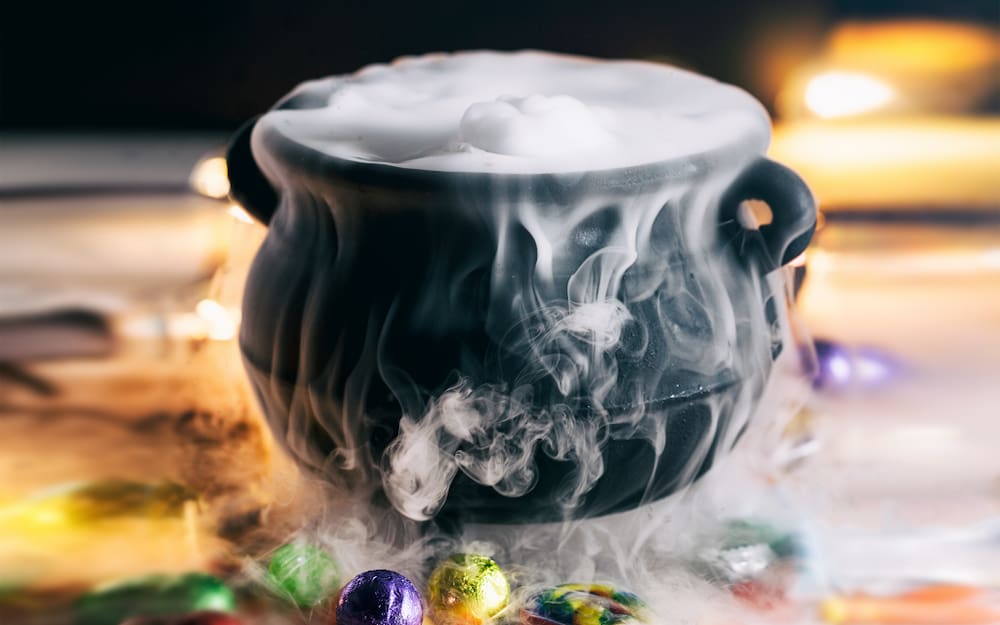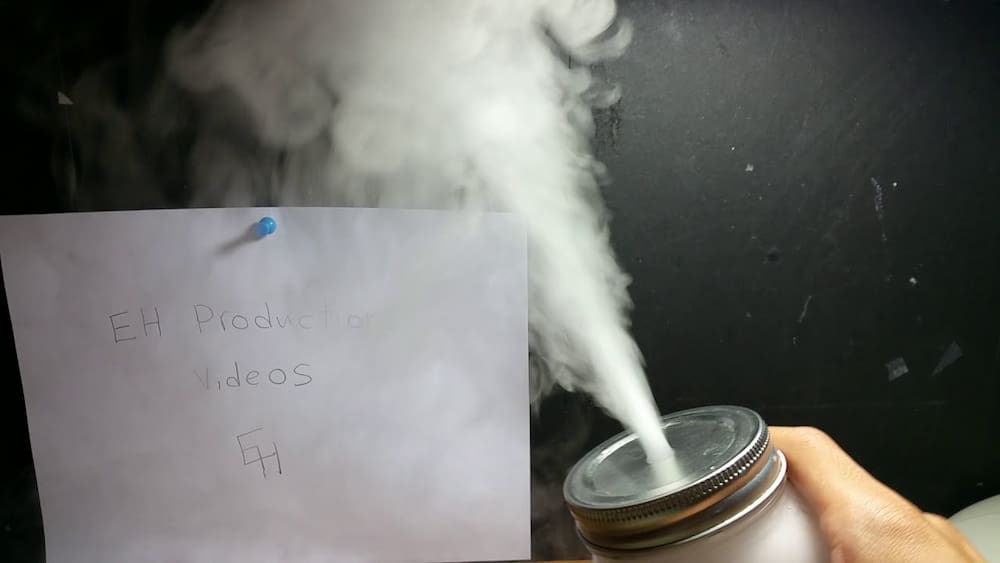
How To Make Dry Ice Smoke? All You Want To Know
As it warms up, dry ice immediately defrosts to become gas again. The thick smoke that is produced when dry ice is submerged in water quickly heats up and can be used for special effects or to set the mood at gatherings. Making dry ice smoke at home is simple, but because handling the ice will make it very cold, make sure to use protective gear.
But, how to make dry ice smoke?
To get the best smoke effects, you must make sure that the water completely covers the dry ice. When the water warms the container, the dry ice will melt into carbon dioxide gas and spill over the edge. As the dry ice warms up from the water, this will occur. Next to the dry ice container, a sign stating that visitors shouldn’t touch the dry ice should be put.
Please continue reading for more information.
Table of Contents
How To Make Dry Ice Smoke?
Submerge Dry Ice In Warm Water
Warm water should be added until the bucket is halfway full. Use the water that comes out of your sink the hottest or warm the water in a big pot. In order for the dry ice to produce a lot of smoke, the water must be at least 50°F (10°C) warmer than that.
When handling dry ice, put on thick gloves. When it comes into contact with your bare skin, dry ice’s extreme cold can result in frostbite. Before using dry ice, put on thick leather gloves to protect your hands from the chilly air. Use a thick, folded towel in place of gloves if you don’t have any on hand so that you can still protect yourself.
Use a hammer to break dry ice into smaller pieces. Put on your gloves, then take the dry ice package out of its insulated container and place it on a solid surface. To break off tiny chunks from the larger block, tap the dry ice with a small hammer. Although bigger pieces won’t produce as much smoke, the smoke will last longer because it takes longer for the smoke to turn to vapor. The most fog will be produced by smaller pieces, but it won’t last as long. At the end, you should have at least 5 pounds (2.3 kg) of dry ice chunks.
The dry ice cubes should be thrown into the water. Transfer the dry ice into your container with the hot water when you are ready to create the smoke. For optimal smoke effects, make sure the dry ice is fully submerged in the water. Dry ice will melt into carbon dioxide gas as a result of the water heating it up, spilling over the edge of the container you are using.
Warning: Since breathing in dry ice smoke could be dangerous if the vapor builds up, ventilate the space with open windows or a fan.Following about 15 minutes, add more dry ice. Only 15 to 30 minutes after it is added, the dry ice stops producing smoke and begins to cool the water. Add another 3.5 pounds (1.4–2.3 kg) of dry ice to the container once it stops producing smoke to get it to start doing so once more. If you want to produce smoke for a while, keep adding dry ice to the container.
Have Fun With Dry Ice Smoke
To cool your beverage down and make it smoke, add dry ice to a punch bowl. For you and your guests, pour the beverage into a sizable punch bowl until it is ¾ full. Add a 1-pound (0.45-kg) piece of dry ice to the bottom of your punch bowl before your guests arrive to help it cool down quickly and produce smoke. If you want the punch to keep smoking after it stops, just add more dry ice.
To give Halloween decorations an eerie appearance, keep dry ice nearby. Dry ice can be used to create smoke, which is ideal for Halloween because it makes everything seem spookier. As an illustration, you could simulate smoke production by placing dry ice and warm water inside a plastic cauldron or a carved pumpkin. Put a small piece of dry ice inside a beaker or goblet that has water in it to create decorations that resemble bubbling potions. Then add 2-3 drops of food coloring to the container.
For a fun experiment, make big bubbles that are smoke-filled with dry ice. 1 US quart (0.95 L) of water should be added to 1 and a half teaspoons (4.9–9.9 ml) of liquid dish soap, and the mixture should be stirred to form suds. Put your dry ice in a different bowl and add water to it so it can float and start emitting smoke. Wring out a towel after dipping it in the soapy water to prevent it from becoming soggy. Pull the towel taut between your hands, and rub it across the top rim of the bowl with dry ice to cover it with a single layer of bubble “skin,” similar to a bubble wand.
Attach a pipe filled with dry ice to a fog machine to make the smoke denser. Use a PVC pipe that is approximately 3 to 4 feet (0.91 to 1.22 meters) long, and drill holes every 6 inches (15 cm) along its length. Put a few pieces of dry ice in the pipe, then connect the other end to the output hose of your fog machine. Fog solution should be poured into the machine, then it should be turned on to begin operating. The machine’s fog will combine with the dry ice vapor to produce smoke that will stay close to the ground and add atmosphere to the space.
To create outdoor smoke, add dry ice to a heated pool or hot tub. When your event is about to begin, throw 50 pounds (23 kg) of dry ice into the water of a heated pool or jacuzzi. Depending on the temperature and the size of the chunks, the dry ice and the heat from the water will continue to emit smoke for a further one to two hours. To prevent accidental injuries, don’t let anyone else swim or relax in the water while there is still dry ice present.
To make the smoke appear a different color in your room, use colored lights. You must use colored lights in place of adding food coloring to the water you use with the dry ice to change the color of the smoke. Instead of purchasing colored lightbulbs for your fixtures, search for light gels, which are thin sheets of translucent color, and place them in front of your lights. Along with adding atmosphere to a gathering or space, this will also ensure that your smoke matches your light in color.

Which Processes Dry Ice Causes Water Fog?
The molecule of carbon dioxide (CO2) is a gas that can also take on the form of dry ice, a solid. It needs to be at least -109.3 degrees Fahrenheit for carbon dioxide to solidify. When dry ice is exposed to air at room temperature, it sublimates, or instantly changes from a solid to a gas, without melting first. Under typical circumstances, this typically happens at a rate of 5 to 10 pounds of dry ice being converted into gaseous carbon dioxide each day. The gas initially has a much lower temperature than the surrounding air. Fog forms when water vapor in the air condenses into small droplets as a result of a sudden drop in air temperature.
There is barely any fog in a dry ice area. Dry ice dropped into water, especially hot water, will, however, have an even greater impact. The carbon dioxide in the water causes cool gas bubbles to form. When bubbles break free at the water’s surface, warm, humid air condenses into thick fog.
Because carbon dioxide is denser than air, it causes the fog to sink to the ground. Once the gas has heated up and begun to evaporate, the fog eventually lifts. By increasing the concentration of carbon dioxide close to the ground, dry ice fog is produced.
A thick, white fog is created when dry ice and warm water are combined. The white fog, which resembles naturally occurring fog, is made up of microscopic water droplets that have been aerosolized. In the water, the dry ice is bubbling as it transforms from a solid to a gas. Because of this, the CO2 gas escapes from the water container and dissipates into the mostly dry air above. The cold CO2 vapour above the box causes water molecules to condense, resulting in minuscule water droplets that are so small they stay suspended in the gas.
The only difference between natural fog and dry ice fog is the presence of gaseous carbon dioxide (CO2) among the water droplets. The white fog is drawn to the ground by CO2 gas, which is denser than air and can produce some interesting effects. The haze spins around people every time they walk through it, spreading out, moving downward. It won’t result in a fine mist rising into the air, unlike glycol-based foggers and hazers. Fog made of dry ice has no smell, uses no chemicals, and leaves no residue.
Dry Ice Fog: How Do I Make It?
Thoughts on “How do dry ice foggers work?” 20 kg of dry ice will be required to chill a large area, such as a dance floor, for 8 to 10 minutes. Simply combine hot water (about 50 degrees Celsius) and dry ice in a container to make fog. The fog effect will be eliminated and the humidity in the air above the container will fall if enough dry ice is applied to the water. For your ideal wedding reception, check out Boutique Events Group Wedding Venue.
The densest fog is created by using hot water. For a prolonged period of time, the fog effect can be maintained by keeping the water warm in a container with the lowest heat setting, such as a rice cooker or slow cooker. Attention: if the heater is turned up too much, thermal currents will disperse the fog and ruin the effect. Candles are ineffective because CO2 is also used in fire extinguishers.
Four to eight gallons of boiling water should have five to ten pounds of Dry Ice added before the mixture is allowed to sit for 15 minutes. This could result in a significant amount of fog, depending on the water’s temperature and the size of the Dry Ice chunks. To increase the amount of fog, add more boiling water.
The cloud of vapour is augmented by the rising steam produced by boiling water. Since there is no steam present, the fog moves downward and with the wind. Using a small fan, you can control the airflow. Because of the larger surface area per unit volume, smaller Dry Ice pieces produce more fog. In both cases, the result is thicker fog that lasts for a shorter time.
With a hot plate, electric skillet, or any other heat source, you can extend the duration of the mist by keeping the water hot. Otherwise, every time the water gets too cold, the fog effects must be restarted. The container should be completely filled with water for the fog to best pour over the sides. However, the water will bubble and splash ferociously as a result of the dry ice being sublimated. Make sure you place the water somewhere where it won’t cause any harm because even a partially full container may splash. Any path that the water vapour fog takes will be covered in moisture. Please be careful because after repeated use, floors can become slick.
How Do I Maintain Dry Ice?
In order to slow the rate at which it sublimates into CO2 gas as much as possible, dry ice must be kept in an airtight, insulated container. The dry ice came in a polystyrene box, which is perfect for storage. No glass or airtight container should be used to store dry ice. Carbon dioxide gas, which is released when dry ice melts, can cause a container to burst.
The volume of the CO2 gas is about 800 times that of the dry ice. Carbon dioxide gas will settle to the ground and push out the air in low-lying areas because it is denser than air. When carbon dioxide concentrations are high enough, it can be fatal as an asphyxiant. Because they don’t have enough ventilation, you should never store dry ice in a cellar, boat hold, or walk-in freezer.
Remember that dry ice in its plastic packaging can be stored in typical home freezers. The dry ice will release carbon dioxide gas while it’s in the fridge, but asphyxiation is not a danger. The ice inside will last longer if the box is cooled in a freezer. However, walk-in freezers shouldn’t be used to store dry ice because if the freezer is not used frequently, the air can become dangerously high in CO2.
Direct contact with Dry Ice could cause damage to nearby surfaces due to its extreme cold. Adhesives may dry out and crack. Please keep dry ice away from the tiles in your kitchen and any other surfaces that might become damaged by the extreme cold.
Dry Ice is best kept and transported in an ice chest. Getting dry ice as close to the time it will be used is ideal because it still sublimates 5–10 pounds per day. When handling dry ice, insulated gloves are advised to be worn. A freezer is not the proper place to store dry ice. Due to the extremely low temperatures, the thermostat on your refrigerator will turn off. (However, it will keep perishables frozen in the event that your refrigerator breaks down.) A sealed container shouldn’t be used to store dry ice. When dry ice melts, carbon dioxide gas is produced, which causes any sealed container to either explode or burst at the seams.
Keep dry ice in an airtight container, like a bag. thick styrofoam box). Longer sublimation times result from greater insulation thickness. The plastic box that is provided can safely store the Dry Ice for up to 72 hours. Without refrigeration, dry ice can be stored at room temperature. It’s best to order dry ice for delivery or pickup on the day it will be used because it has a limited shelf life. Never keep dry ice in a closed container without airflow. When dry ice melts, carbon dioxide gas is released, which can cause an airtight container to expand or even break. The area where dry ice is kept needs to have enough airflow. Dry Ice needs to be stored in a space that is well-ventilated. Dry ice will sublimate carbon dioxide gas, which will settle in low areas and replace the oxygenated air there.
Does Dry Ice Melt?
Due to the absence of a liquid state, or more commonly, due to the fact that it does not melt, dry ice gets its name. Instead, the moment dry ice is produced, it begins the process of gradually reverting back to its gaseous state and continues to do so forever after.When it comes to your special day, Boutique Events Group has proven itself to be an iconic wedding venue and function centre in Melbourne
What Precautions Should I Make For Safety?
- If you must handle dry ice, put on insulated gloves, preferably ones with a closed cuff.
- It is crucial to safeguard one’s eyes when handling larger pieces of dry ice, such as blocks or slices.
- Maintain the box in a space that is properly ventilated because dry ice produces carbon monoxide.
This is the perfect formula for atmospheric air: 78% nitrogen, 21% oxygen, and 0.035 percent carbon dioxide. When atmospheric carbon dioxide concentrations exceed 0.5%, harm may result. If there is too much CO2 in the air, you will start panting and breathing more quickly. Low areas need ventilation systems because dry ice CO2 tends to collect there because it is heavier than air. Any closed storage space that has previously held dry ice should not be entered without first allowing it to completely dry out.
Frequently Asked Questions
What Happens When Dry Ice Is Spun Into The Air?
As solid carbon dioxide, dry ice has a temperature of -78.5 degrees Celsius. The air around it will cool significantly when it abruptly changes state from a solid to a gas, a process known as sublimation.
At this point, the solubility of water declines, causing the air around us to condense into an infinite number of tiny droplets that we call fog.
Why Is Dry Ice Different From Water Ice?
Additionally, dry ice, a form of carbon dioxide, is possible. Its main use is as a cooling agent, but it is also used in theater fog machines to produce dramatic effects. It has a lower temperature than water ice and leaves no traces. In addition to the incidental frost caused by atmospheric moisture, these benefits exist.
How Can Dry Ice Be Prevented From Fogging?
It is necessary to follow all safety precautions when handling dry ice. Every 5–10 minutes, add a few pieces of dry ice to a container made of metal or plastic that is halfway filled with hot water. More hot water must be added if you want to maintain the fog effect after the water has cooled.
What Duration Does The Dry Ice Take To Smoke?
(Never touch the dry ice! – Use tongs only!) ), add a chunk of dry ice measuring one inch to the glass or the larger chunks to the punch bowl. The moment the dry ice hits the bottom of the bowl, it starts to smoke. The ice cube will melt in a single cup in about five minutes, but it will take between five and ten minutes in a punch bowl.
Final Words
Add a few pieces of dry ice every 5–10 minutes to a metal or plastic container half-filled with hot water. To keep the fog effect, you’ll need to keep adding hot water as the water cools. One pound of dry ice will typically produce a fog effect that lasts for two to three minutes. More fog forms at higher water temperatures, but dry ice sublimates more quickly.
White fog is produced when warm or hot water and dry ice are combined. This white fog is condensed water vapor, mixed in with the invisible CO2. Water vapor is forced to condense into clouds by the extreme cold. The fog is heavy, being carried by the CO2, and will settle to the bottom of a container. This can be poured out to create enough fog to cover about a pound of dry ice and a medium-sized room. Do not allow anyone (including pets) to lie in this fog because too much CO2 is toxic.
I appreciate your reading.


